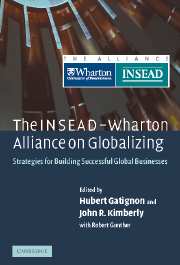Book contents
- Frontmatter
- Contents
- List of figures
- List of tables
- Notes on contributors
- Foreword
- Acknowledgments
- 1 Globalization and its challenges
- Part I Leading the global organization
- Part II Global market participation
- Part III Managing risk and uncertainty
- 11 Cross-border valuation: the international cost of equity capital
- 12 Managing risk in global supply chains
- 13 Global recombination: cross-border technology and innovation management
- 14 From corporate social responsibility to global citizenship
- 15 Colliding forces: domestic politics and the global economy
- 16 Global implications of information and communication technologies (ICT)
- Part IV Implications and conclusions
- Author index
- Subject index
11 - Cross-border valuation: the international cost of equity capital
from Part III - Managing risk and uncertainty
Published online by Cambridge University Press: 14 January 2010
- Frontmatter
- Contents
- List of figures
- List of tables
- Notes on contributors
- Foreword
- Acknowledgments
- 1 Globalization and its challenges
- Part I Leading the global organization
- Part II Global market participation
- Part III Managing risk and uncertainty
- 11 Cross-border valuation: the international cost of equity capital
- 12 Managing risk in global supply chains
- 13 Global recombination: cross-border technology and innovation management
- 14 From corporate social responsibility to global citizenship
- 15 Colliding forces: domestic politics and the global economy
- 16 Global implications of information and communication technologies (ICT)
- Part IV Implications and conclusions
- Author index
- Subject index
Summary
How does a firm in one country evaluate an investment in a firm in another country, or how does it evaluate a foreign project that the firm itself is undertaking? Both questions are increasingly important as international mergers and acquisitions grow and as firms become more multinational in their operations. In domestic markets, managers would typically estimate future free cash flows to equity of the investment and discount these cash flows at some appropriate rate, using the classic Capital Asset Pricing Model (CAPM). The CAPM, however, has several problems when applied to global markets. First, it requires an equity premium, or the excess return of the broad equity market over the risk-free rate, which is quite complicated to determine in global markets. For example, should a US-based firm considering an acquisition in China use the equity premium from its home market or from China? Further, there are other forms of global risk that the CAPM ignores completely. How can managers take into account the broader risks of global markets such as currency risk and political risk? In this chapter, the authors examine ways to make the CAPM a more robust tool for assessing global investments. They propose ways for managers to address differences in equity premiums and integrate considerations of currency and political risks into the CAPM. Finally, they examine an approach that is especially useful in analyzing investments in developing countries.
- Type
- Chapter
- Information
- The INSEAD-Wharton Alliance on GlobalizingStrategies for Building Successful Global Businesses, pp. 255 - 287Publisher: Cambridge University PressPrint publication year: 2004
- 2
- Cited by



